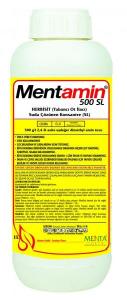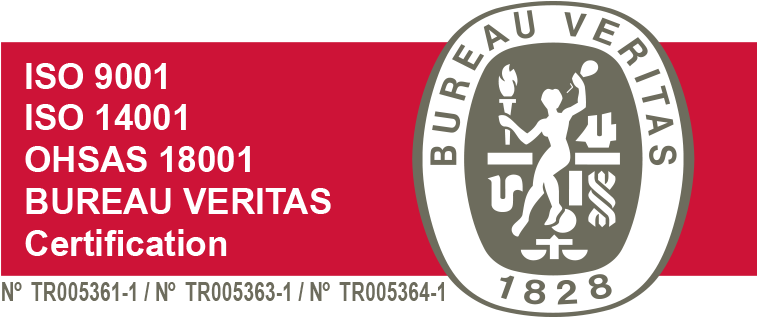Product Certificate and Label
| Name Of The Product | : | MENTAMİN 500 SL |
| Active Substance | : | 2,4-D acid equivalent dimethyl amine salt |
| Formulation Form | : | Water-Soluble Concentrate (SL) |
| Specification | : | |
| Group | : | O,4 HERBICIDE |
| Toxicity | : | |
| Environmental Impact | : | Toxic for bees. Toxic for fish. |
| Antidote | : | No special antidote. Symptomatic treatment is applied. |
FORM OF MARKET PRESENTATION : 0,1 L - 0,25 L - 0,50 L - 1 L - 5 L - 20 L
PREPARATION OF THE PLANT PROTECTION PRODUCT TO BE APPLIED:
First, the Plant Protection Product scaled on recommendation dose is mixed with a small amount of clean water in a separate container. The application machine tank is filled halfway with water. The mix is added to the tank while the mixer is running. Mixing is continued while the tank is completed with water. Mixing is continued until the application is completed. The amount of water to be used per decare should be 20-40 liters and fan jet nozzles should be used in applications.
Calibration:
In order to determine the amount of water to be used per decare, the tank of the machine is filled with water. It is determined how much area is wetted with this water and the amount of water to be used in the application is calculated.
CLEANING OF APPLICATION MACHINE:
Safely empty the storage of the application machine immediately after the application is completed. After filling the tank with clean water, start the mixer and spray system to ensure that all parts are washed. Do not wash near water sources. Do not drain washing water and waste into water sources.
USAGE OF PLANT PROTECTION PRODUCT:
The best results are obtained when used during the period when weeds develop rapidly. The ideal amount of water to be used per decare is 20-40 liters. Applications should be made using 3 atm pressure and fan jet nozzles. Do not apply in very windy weather and if the temperature is lower than 10-12 °C. Application should be discontinued when wind speed is more than 16 km/h.
MISCIBILITY:
It is not recommended to be mixed with other plant protection products.
PLANTS AND WEEDS WHICH IT IS USED
|
Plant Name |
Name of Harmful Organisms |
Usage Dosages and Period |
|
CEREALS |
Adonis (Adonis Spp.) Ranunculales (Adonis Flammea) Corncokle (Agrostemma Githago) Scarlet Pimpernel (Anagallis Arvensis) Bugloss (Anchusa Leptophylla) Chamomile (Anthemis Spp.) Corn Chamomile (Anthemis Arvensis) Corn Gromwell (Buglossoides Arvensis) Rampion Bellflower (Campanula Rapunculoides) Small Bur-parsley (Caucalis Platycarpos) Shepherd's Purse (Capsella Bursa-pastoris) Yellow Star-thistle (Centaurea Solsititialis) Cephalaria (Cephalaria Syriaca) Cerastium (Cerastium Perfoliatum) Yellow Honeywort (Cerinthe Minor) Goosefoot (Chenopodium Album) Rush Skeletonweed (Chondrilla Juncea) Chicory (Cichorium Intybus) Larkspur (Consolida Anthoroidea) Anatolian Pink (Dianthus Anatolicus) Heron’s Bill (Erodium Hoeffianum) Mole Plants (Euphorbia Microsphaera) Field Horsetail (Equisetum Arvense) Anatolian Fumitory (Fumaria Kralikii) Fumitory (Fumaria Officinalis) Few-flower Fumitory (Fumaria Vaillantii) Cranesbill (Geranium Spp.) Dyer’s Woad (Isatis Tinctoria) Prickly Lettuce (Lactuca Serriola) Vetchling (Lathyrus Spp.) Hoary Cress (Cardaria Draba) Greater Henbit (Lamium Amplexicaule) Yellow Vetchling (Lathyrus Aphaca) Common Mallow (Malva Sylvestris) Melilot (Melilotus Indica) Yellow-flowered Herb (Melilotus Officinalis) Common Poppy (Papaver Rhoeas) Knotgrass (Polygonum Aviculare) Corn Buttercup (Ranunculus Arvensis) Wild Radish (Raphanus Raphanistrum) Yellow Mignonette (Reseda Lutea) Groundsel (Senecio Vernalis) Charlock (Sinapis Arvensis) Hedge Mustard (Sisymbrium Officinale) Chickweed (Stellaria Media) Salsify (Tragopogon Buphthalmoides) Greater Bur-pasley (Turgenia Latifolia) Cowherb (Vaccaria Pyramidata) Artemisia (Veronica Persica) Vetches (Vicia Spp.) |
160 m/da at the beginning of tillering period
200 m/da at the end of tillering period
300 m/da It is used in the late-period in the Black Sea Region.
It is recommended for polyculture farming area. |
|
CORN |
Red-rooted Pigweed (Amaranthus Retroflexus) Goosefoot (Chenopodium Album) Heliotrope (Heliotropium Europaeum) Wild Radish (Raphanus Raphanistrum) Charlock (Sinapis Arvensis) Perennial Sow Thistle)
|
200 m/da After postemerge, corns should be at the stage of 2-4 leaves.
|




